Sparkling Wines Market
Sparkling Wines Market Size and Share Forecast Outlook 2025 to 2035
The sparkling wines market is projected to grow from USD 46.0 billion in 2025 to USD 58.9 billion by 2035, at a CAGR of 2.5%. Prosecco/Charmat will dominate with a 39.0% market share, while brut/extra brut will lead the sweetness segment with a 54.0% share.
Sparkling Wines Market Forecast and Outlook 2025 to 2035
The global sparkling wines market is valued at USD 46.0 billion in 2025 and is slated to reach USD 59.0 billion by 2035, recording an absolute increase of USD 13.0 billion over the forecast period. This translates into a total growth of 28.3%, with the market forecast to expand at a compound annual growth rate (CAGR) of 2.5% between 2025 and 2035. The overall market size is expected to grow by nearly 1.3X during the same period, supported by increasing celebration culture adoption, growing premium beverage consumption, and rising implementation of diverse sparkling wine varieties across beverage retail and hospitality applications.
Quick Stats for Sparkling Wines Market
- Sparkling Wines Market Value (2025): USD 46.0 billion
- Sparkling Wines Market Forecast Value (2035): USD 59.0 billion
- Sparkling Wines Market Forecast CAGR: 2.5%
- Leading Type in Sparkling Wines Market: Prosecco/Charmat (39.0%)
- Key Growth Regions in Sparkling Wines Market: North America, Europe, and Asia Pacific
- Key Players in Sparkling Wines Market: LVMH (Moët Hennessy), Campari Group (Riccadonna), Henkell-Freixenet, Constellation, Pernod Ricard
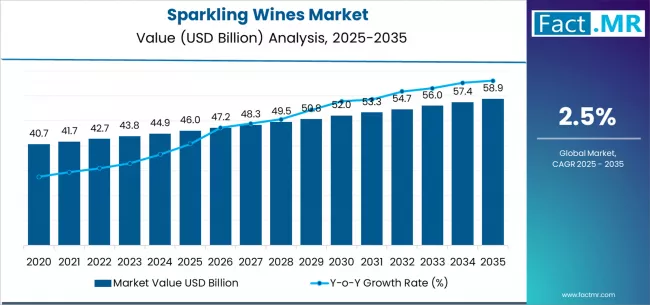
Between 2025 and 2030, the sparkling wines market is projected to expand from USD 46.0 billion to USD 51.8 billion, resulting in a value increase of USD 5.8 billion, which represents 44.6% of the total forecast growth for the decade. This phase of development will be shaped by increasing premium beverage consumption recovery, rising celebration occasions frequency, and growing adoption of diverse sparkling wine options in retail and hospitality operations. Wine producers are expanding their production capabilities to address the growing demand for quality sparkling products and enhanced consumer experiences.
Sparkling Wines Market Key Takeaways
| Metric | Value |
|---|---|
| Estimated Value in (2025E) | USD 46.0 billion |
| Forecast Value in (2035F) | USD 59.0 billion |
| Forecast CAGR (2025 to 2035) | 2.5% |
From 2030 to 2035, the market is forecast to grow from USD 51.8 billion to USD 59.0 billion, adding another USD 7.2 billion, which constitutes 55.4% of the overall ten-year expansion. This period is expected to be characterized by the expansion of premium and artisanal wine systems, the integration of digital marketing platforms, and the development of innovative sparkling wine varieties for diverse consumer preferences. The growing adoption of wine tourism programs and experiential consumption initiatives will drive demand for sparkling wines with enhanced quality positioning and improved brand differentiation.
Between 2020 and 2025, the sparkling wines market experienced steady recovery growth, driven by increasing social celebration demand recovery and growing recognition of sparkling wines as essential beverage category for special occasions and premium consumption experiences. The market developed as consumers and hospitality providers recognized the potential for quality sparkling wines to enhance celebration experiences while supporting social occasions and lifestyle enhancement. Technological advancement in wine production and packaging systems began emphasizing the critical importance of maintaining product quality and brand positioning in beverage retail operations.
Why is the Sparkling Wines Market Growing?
Market expansion is being supported by the increasing global celebration culture and the corresponding need for premium beverage options that can enhance social occasions and consumer experiences while supporting diverse hospitality applications across various retail environments. Modern consumers and hospitality providers are increasingly focused on implementing beverage solutions that can elevate celebrations, provide quality experiences, and deliver consistent performance in social and retail settings. Sparkling wines' proven ability to deliver enhanced celebration experiences, reliable quality capabilities, and versatile occasion applications make them essential beverages for contemporary social operations and hospitality solutions.
The growing emphasis on premium beverage modernization and experience enhancement is driving demand for sparkling wines that can support diverse celebrations, provide quality differentiation, and enable efficient retail operations across varying consumer preferences. Consumer preference for beverages that combine tradition with quality and accessibility is creating opportunities for innovative product implementations. The rising influence of social media marketing and lifestyle branding is also contributing to increased adoption of sparkling wines that can provide premium positioning without compromising taste quality or celebration authenticity.
Opportunity Pathways - Sparkling Wines Market
The sparkling wines market is poised for robust growth and transformation. As consumers and hospitality providers across both developed and emerging markets seek beverage options that are premium, diverse, accessible, and celebration-focused, sparkling wine systems are gaining prominence not just as alcoholic beverages but as strategic solutions for occasion enhancement, lifestyle expression, social positioning, and hospitality differentiation.
Rising celebration frequency and premium consumption in North America, Europe, and Asia Pacific amplify demand, while producers are picking up on innovations in production methods and brand positioning.
Pathways like premium positioning, organic varieties, and experiential marketing promise strong margin uplift, especially in developed markets. Geographic expansion and occasion diversification will capture volume, particularly where celebration culture is growing or premium beverage infrastructure requires modernization. Social experience pressures around quality enhancement, occasion celebration, lifestyle expression, and brand differentiation give structural support.
- Pathway A - Premium & Luxury Positioning. Consumers increasingly seek high-quality sparkling wines with heritage and craftsmanship appeal. Wine producers who specialize in premium production or enhance luxury capabilities can command a premium. Expected revenue pool: USD 2.8-3.5 billion
- Pathway B - Organic & Natural Wine Solutions. Advanced production systems -- organic grapes, natural processes, clean labeling -- improve health positioning and environmental appeal. Opportunity: USD 2.2-2.9 billion
- Pathway C - Experiential & Tourism Integration. Wine tourism experiences, tasting events, and brand storytelling optimize consumer engagement and brand loyalty. Systems with stronger experiential capabilities will allow premium positioning. Revenue lift: USD 1.8-2.5 billion
- Pathway D - Specialized Occasion Applications. Extending reach into wedding markets, corporate events, and seasonal celebrations. Event organizers will look for wine suppliers who provide reliable, premium celebration solutions. Pool: USD 2.0-2.7 billion
- Pathway E - Emerging Market Expansion. Strong growth in developing celebration markets, urbanization trends, and disposable income growth. Local partnerships and distribution networks help penetration. Expected upside: USD 1.5-2.2 billion
- Pathway F - Digital Marketing & E-Commerce. Online sales platforms, digital marketing campaigns, and direct-to-consumer sales help optimize market reach and brand positioning. Digital approaches benefit from consumer convenience preferences. USD 1.2-1.9 billion
- Pathway G - Innovation & Flavor Diversification. New flavor profiles, low-alcohol options, and innovative packaging create differentiation and consumer appeal advantages. Pool: USD 1.0-1.7 billion
Segmental Analysis
The market is segmented by type, sweetness, and channel. By type, the market is divided into Prosecco/Charmat, Champagne/Traditional, and Cava & others. By sweetness, it covers Brut/extra brut, Demi-sec, and Sweet. By channel, it is segmented into off-trade and on-trade. Regionally, the market is divided into North America, Europe, Asia Pacific, Latin America, and Middle East & Africa.
By Type, the Prosecco/Charmat Segment Accounts for 39.0% Market Share
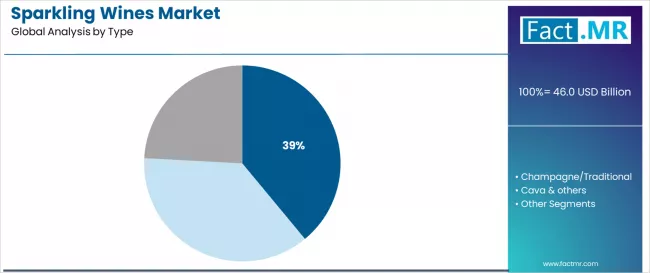
The Prosecco/Charmat type segment is projected to account for 39.0% of the sparkling wines market in 2025, reaffirming its position as the leading production method category. Wine consumers and retail providers increasingly prefer Prosecco/Charmat wines for their proven accessibility, established flavor profile, and cost-effectiveness in sparkling wine consumption across celebration occasions, social gatherings, and casual consumption applications. Prosecco/Charmat production technology's established manufacturing procedures and consistent quality output directly address the consumer requirements for affordable luxury and enjoyable drinking experiences in diverse social environments.
This type segment forms the foundation of current sparkling wine operations, as it represents the production method with the greatest market accessibility and established consumer acceptance across multiple occasions and consumption scenarios. Consumer investments in enhanced Prosecco varieties and quality optimization continue to strengthen adoption among wine enthusiasts and casual consumers. With consumers prioritizing quality-price balance and approachable taste profiles, Prosecco/Charmat wines align with both celebration objectives and budget considerations, making them the central component of comprehensive sparkling wine strategies.
By Sweetness, the Brut/Extra Brut Segment Accounts for 54.0% Market Share
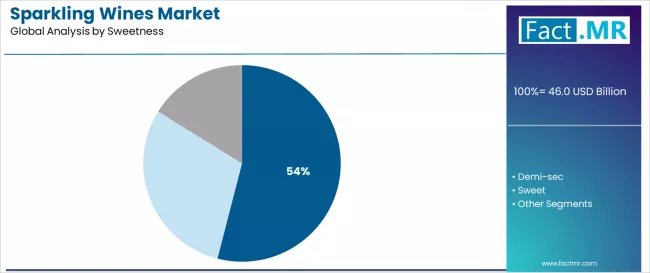
Brut/extra brut sweetness levels are projected to represent 54.0% of sparkling wines preference in 2025, underscoring their critical role as the primary taste preference for sophisticated consumers and food pairing applications. Wine consumers prefer brut/extra brut sparkling wines for their dry character, established pairing versatility, and ability to complement diverse dining experiences while supporting culinary enhancement and sophisticated consumption requirements. Positioned as premium choice for modern wine consumption, brut/extra brut wines offer both taste sophistication and culinary advantages.
The segment is supported by continuous innovation in wine production and the growing availability of specialized dry sparkling configurations that enable refined taste experiences with enhanced food compatibility. Additionally, consumers are investing in taste sophistication to support culinary exploration and dining enhancement. As food pairing becomes more prevalent and taste refinement requirements increase, brut/extra brut sweetness will continue to dominate the sweetness market while supporting advanced culinary experiences and consumer satisfaction strategies.
By Channel, the Off-Trade Segment Accounts for 74.0% Market Share
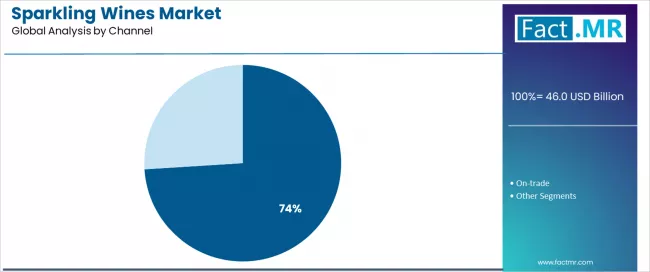
Off-trade channels are projected to represent 74.0% of sparkling wines distribution in 2025, underscoring their critical role as the primary retail setting for home consumption and celebration preparation. Retail providers prefer off-trade sparkling wine sales for their volume capabilities, established inventory management, and ability to support consumer convenience while maintaining product availability and competitive pricing requirements. Positioned as essential retail infrastructure for modern wine commerce, off-trade channels offer both distribution advantages and consumer accessibility benefits.
The segment is supported by continuous innovation in retail wine merchandising and the growing availability of specialized product presentations that enable effective consumer selection with enhanced shopping experiences. Additionally, retailers are investing in wine category optimization to support sales growth and consumer education delivery. As home entertainment becomes more prevalent and convenience requirements increase, off-trade channels will continue to dominate the distribution market while supporting advanced retail strategies and consumer accessibility initiatives.
What are the Drivers, Restraints, and Key Trends of the Sparkling Wines Market?
The sparkling wines market is advancing steadily due to increasing celebration culture adoption and growing implementation of premium beverage infrastructure that provides enhanced social experiences and occasion enhancement across diverse hospitality applications. However, the market faces challenges, including grape supply fluctuations, regulatory compliance complexities, and varying consumer preferences across different regional environments. Innovation in production technologies and marketing approaches continues to influence product development and market expansion patterns.
Rising Global Celebration Culture and Premium Consumption Trends
The growing expansion of social celebrations and premium beverage consumption is enabling wine producers to develop sparkling wine systems that provide superior taste experiences, enhanced occasion suitability, and reliable performance in diverse social environments. Advanced production systems provide improved quality capacity while allowing more effective celebration enhancement and consistent consumer satisfaction across various applications and social requirements. Producers are increasingly recognizing the competitive advantages of modern production capabilities for brand positioning and consumer loyalty building.
Digital Marketing and Experience Innovation Drive Product Development
Modern sparkling wine producers are incorporating digital marketing strategies and experiential programs to enhance brand visibility, improve consumer engagement, and ensure consistent performance delivery to wine consumers. These approaches improve market positioning while enabling new applications, including wine tourism and direct-to-consumer sales solutions. Advanced marketing integration also allows producers to support premium product positioning and consumer relationship optimization beyond traditional wine retail supply.
Analysis of the Sparkling Wines Market by Key Countries
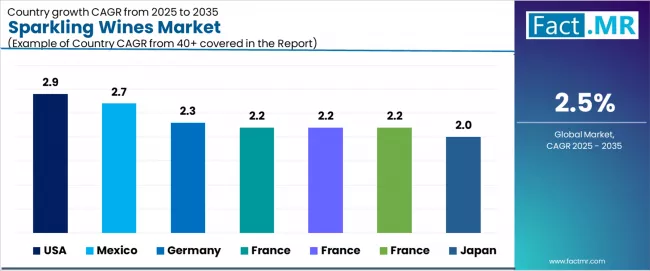
| Country | CAGR (2025-2035) |
|---|---|
| USA | 2.9% |
| Mexico | 2.7% |
| Germany | 2.3% |
| France | 2.2% |
| South Korea | 2.2% |
| United Kingdom | 2.2% |
| Japan | 2.0% |
The sparkling wines market is experiencing steady growth globally, with the USA leading at a 2.9% CAGR through 2035, driven by extensive celebration culture development, advanced beverage retail infrastructure, and significant adoption of premium wine consumption trends. Mexico follows at 2.7%, supported by growing celebration traditions, rapid urbanization trends, and growing adoption of premium beverage options. Germany shows growth at 2.3%, emphasizing quality standards and traditional wine culture. France, South Korea, and United Kingdom record 2.2%, focusing on heritage preservation and market modernization. Japan demonstrates 2.0% growth, supported by premium consumption trends but constrained by market maturity.
The report covers an in-depth analysis of 40+ countries; seven top-performing countries are highlighted below.
USA Leads Global Market Growth with Celebration Culture Infrastructure
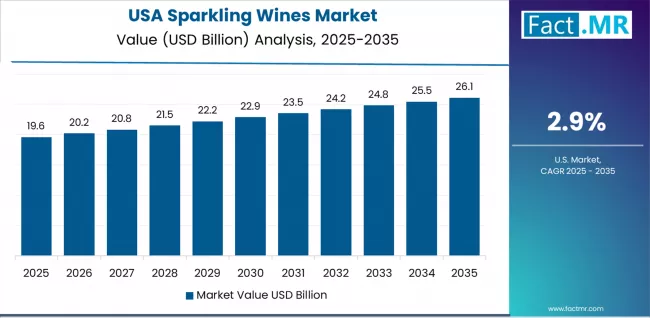
Revenue from sparkling wines in the USA is projected to exhibit exceptional growth with a CAGR of 2.9% through 2035, driven by extensive celebration culture infrastructure and rapidly growing adoption of premium wine consumption supported by social media influence and lifestyle enhancement initiatives. The country's comprehensive beverage retail ecosystem and increasing investment in wine market development are creating substantial demand for diverse sparkling wine solutions. Major wine retailers and hospitality providers are establishing comprehensive sparkling wine programs to serve both consumer demand and celebration requirements.
- Strong celebration culture presence and lifestyle marketing influence is driving demand for premium sparkling wine varieties throughout major retail chains and hospitality venues.
- Robust disposable income levels and expanding network of wine retail outlets are supporting the rapid adoption of diverse sparkling wine options among consumers seeking enhanced celebration experiences and social positioning.
Mexico Demonstrates Strong Market Potential with Celebration Infrastructure Expansion
Revenue from sparkling wines in Mexico is expanding at a CAGR of 2.7%, supported by the country's growing celebration traditions, extensive urbanization development, and increasing adoption of premium beverage systems. The country's comprehensive social modernization and expanding middle class lifestyle preferences are driving sophisticated wine consumption. Urban consumers and hospitality providers are establishing extensive sparkling wine availability to address the growing demand for celebration enhancement and social positioning.
- Rising celebration frequency and expanding urban lifestyle development are creating opportunities for sparkling wine adoption across consumers, retailers, and hospitality providers in major metropolitan regions.
- Growing tourism industry focus and hospitality modernization is driving adoption of premium wine options among providers seeking enhanced customer experiences and competitive positioning.
Europe Market Split by Countries
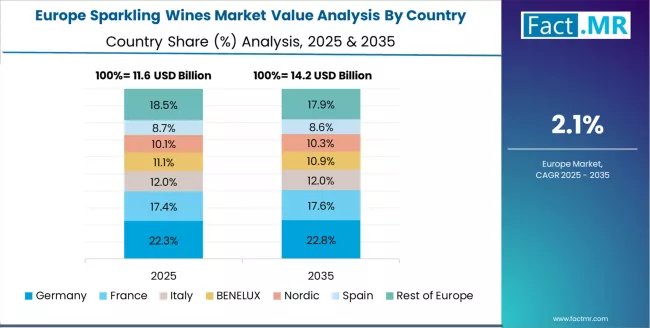
The sparkling wines market in Europe is projected to grow from USD 24.2 billion in 2025 to USD 29.8 billion by 2035, registering a CAGR of 2.1% over the forecast period. France is expected to maintain its leadership position with a 31.8% market share in 2025, increasing to 32.2% by 2035, supported by its traditional champagne heritage, comprehensive wine production infrastructure, and major wine regions serving European and international markets.
Germany follows with a 22.4% share in 2025, projected to ease to 21.9% by 2035, driven by quality wine production programs, traditional wine culture, and established consumer preferences, but facing challenges from competitive pressures and changing consumption patterns. Italy holds a 18.9% share in 2025, expected to decline to 18.6% by 2035, supported by Prosecco production excellence and wine tourism development but facing challenges from market competition and regulatory constraints. Spain commands a 13.2% share in 2025, projected to reach 13.4% by 2035, while United Kingdom accounts for 8.7% in 2025, expected to reach 8.8% by 2035. The Rest of Europe region, including Nordic countries, Eastern European markets, Austria, Belgium, and other European countries, is anticipated to gain momentum, expanding its collective share from 5.0% to 5.1% by 2035, attributed to increasing wine appreciation across Nordic countries and growing premium consumption across various European markets implementing wine culture enhancement programs.
Competitive Landscape of the Sparkling Wines Market
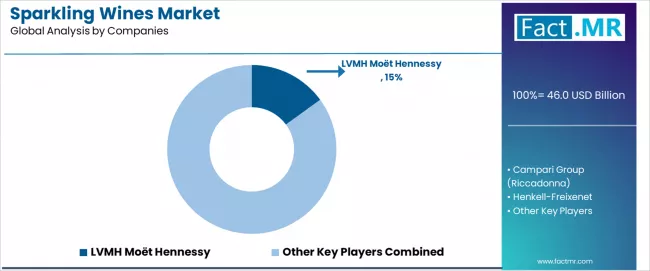
The sparkling wines market is characterized by competition among established wine conglomerates, specialized sparkling wine producers, and integrated beverage companies. Companies are investing in advanced production research, brand development, marketing optimization, and comprehensive product portfolios to deliver premium, authentic, and market-appealing sparkling wine solutions. Innovation in production methods, brand positioning, and consumer engagement capabilities is central to strengthening market position and competitive advantage.
LVMH (Moët Hennessy) leads the market with a 17.0% market share, offering premium sparkling wine brands with a focus on luxury positioning and heritage authenticity for celebration occasions. Campari Group (Riccadonna) provides diverse wine portfolios with an emphasis on Italian heritage, brand recognition, and European market services. Henkell-Freixenet delivers comprehensive sparkling wine collections with a focus on international distribution and quality consistency. Constellation specializes in wine brands with emphasis on market accessibility and consumer preference alignment. Pernod Ricard focuses on premium spirits and wines with global distribution leadership and brand management capabilities. Accolade offers wine solutions with emphasis on consumer value and market positioning. The Wine Group provides diverse wine brands with emphasis on retail partnerships and volume distribution.
Key Players in the Sparkling Wines Market
- LVMH Moët Hennessy
- Campari Group (Riccadonna)
- Henkell-Freixenet
- Constellation Brands, Inc.
- Pernod Ricard S.A.
- Accolade Wines
- The Wine Group, LLC
- Treasury Wine Estates
- Diageo plc
- Viña Concha y Toro S.A.
Scope of the Report
| Items | Values |
|---|---|
| Quantitative Units (2025) | USD 46.0 Billion |
| Type | Prosecco/Charmat, Champagne/Traditional, Cava & others |
| Sweetness | Brut/extra brut, Demi-sec, Sweet |
| Channel | Off-trade, On-trade |
| Regions Covered | North America, Europe, Asia Pacific, Latin America, Middle East & Africa |
| Countries Covered | United States, Canada, Germany, United Kingdom, France, China, Japan, Brazil, India and 40+ countries |
| Key Companies Profiled | LVMH (Moët Hennessy), Campari Group (Riccadonna), Henkell-Freixenet, Constellation, Pernod Ricard, Accolade, and The Wine Group |
| Additional Attributes | Wine sales by type and channel category, regional demand trends, competitive landscape, technological advancements in production systems, marketing development, brand innovation, and consumer engagement optimization |
Sparkling Wines Market by Segments
-
Type :
- Prosecco/Charmat
- Champagne/Traditional
- Cava & others
-
Sweetness :
- Brut/extra brut
- Demi-sec
- Sweet
-
Channel :
- Off-trade
- On-trade
-
Region :
-
North America
- United States
- Canada
- Mexico
-
Europe
- Germany
- United Kingdom
- France
- Italy
- Spain
- Nordic
- BENELUX
- Rest of Europe
-
Asia Pacific
- China
- Japan
- India
- South Korea
- ASEAN
- Australia & New Zealand
- Rest of Asia Pacific
-
Latin America
- Brazil
- Chile
- Rest of Latin America
-
Middle East & Africa
- Kingdom of Saudi Arabia
- Other GCC Countries
- Turkey
- South Africa
- Other African Union
- Rest of Middle East & Africa
-
Table of Content
- Executive Summary
- Global Market Outlook
- Demand to side Trends
- Supply to side Trends
- Technology Roadmap Analysis
- Analysis and Recommendations
- Market Overview
- Market Coverage / Taxonomy
- Market Definition / Scope / Limitations
- Market Background
- Market Dynamics
- Drivers
- Restraints
- Opportunity
- Trends
- Scenario Forecast
- Demand in Optimistic Scenario
- Demand in Likely Scenario
- Demand in Conservative Scenario
- Opportunity Map Analysis
- Product Life Cycle Analysis
- Supply Chain Analysis
- Investment Feasibility Matrix
- Value Chain Analysis
- PESTLE and Porter’s Analysis
- Regulatory Landscape
- Regional Parent Market Outlook
- Production and Consumption Statistics
- Import and Export Statistics
- Market Dynamics
- Global Market Analysis 2020 to 2024 and Forecast, 2025 to 2035
- Historical Market Size Value (USD Million) Analysis, 2020 to 2024
- Current and Future Market Size Value (USD Million) Projections, 2025 to 2035
- Y to o to Y Growth Trend Analysis
- Absolute $ Opportunity Analysis
- Global Market Pricing Analysis 2020 to 2024 and Forecast 2025 to 2035
- Global Market Analysis 2020 to 2024 and Forecast 2025 to 2035, By Type
- Introduction / Key Findings
- Historical Market Size Value (USD Million) Analysis By Type , 2020 to 2024
- Current and Future Market Size Value (USD Million) Analysis and Forecast By Type , 2025 to 2035
- Prosecco/Charmat
- Champagne/Traditional
- Cava & others
- Y to o to Y Growth Trend Analysis By Type , 2020 to 2024
- Absolute $ Opportunity Analysis By Type , 2025 to 2035
- Global Market Analysis 2020 to 2024 and Forecast 2025 to 2035, By Sweetness
- Introduction / Key Findings
- Historical Market Size Value (USD Million) Analysis By Sweetness, 2020 to 2024
- Current and Future Market Size Value (USD Million) Analysis and Forecast By Sweetness, 2025 to 2035
- Brut/extra brut
- Demi-sec
- Sweet
- Y to o to Y Growth Trend Analysis By Sweetness, 2020 to 2024
- Absolute $ Opportunity Analysis By Sweetness, 2025 to 2035
- Global Market Analysis 2020 to 2024 and Forecast 2025 to 2035, By Channel
- Introduction / Key Findings
- Historical Market Size Value (USD Million) Analysis By Channel, 2020 to 2024
- Current and Future Market Size Value (USD Million) Analysis and Forecast By Channel, 2025 to 2035
- Off-trade
- On-trade
- Y to o to Y Growth Trend Analysis By Channel, 2020 to 2024
- Absolute $ Opportunity Analysis By Channel, 2025 to 2035
- Global Market Analysis 2020 to 2024 and Forecast 2025 to 2035, By Region
- Introduction
- Historical Market Size Value (USD Million) Analysis By Region, 2020 to 2024
- Current Market Size Value (USD Million) Analysis and Forecast By Region, 2025 to 2035
- North America
- Latin America
- Western Europe
- Eastern Europe
- East Asia
- South Asia and Pacific
- Middle East & Africa
- Market Attractiveness Analysis By Region
- North America Market Analysis 2020 to 2024 and Forecast 2025 to 2035, By Country
- Historical Market Size Value (USD Million) Trend Analysis By Market Taxonomy, 2020 to 2024
- Market Size Value (USD Million) Forecast By Market Taxonomy, 2025 to 2035
- By Country
- USA
- Canada
- Mexico
- By Type
- By Sweetness
- By Channel
- By Country
- Market Attractiveness Analysis
- By Country
- By Type
- By Sweetness
- By Channel
- Key Takeaways
- Latin America Market Analysis 2020 to 2024 and Forecast 2025 to 2035, By Country
- Historical Market Size Value (USD Million) Trend Analysis By Market Taxonomy, 2020 to 2024
- Market Size Value (USD Million) Forecast By Market Taxonomy, 2025 to 2035
- By Country
- Brazil
- Chile
- Rest of Latin America
- By Type
- By Sweetness
- By Channel
- By Country
- Market Attractiveness Analysis
- By Country
- By Type
- By Sweetness
- By Channel
- Key Takeaways
- Western Europe Market Analysis 2020 to 2024 and Forecast 2025 to 2035, By Country
- Historical Market Size Value (USD Million) Trend Analysis By Market Taxonomy, 2020 to 2024
- Market Size Value (USD Million) Forecast By Market Taxonomy, 2025 to 2035
- By Country
- Germany
- UK
- Italy
- Spain
- France
- Nordic
- BENELUX
- Rest of Western Europe
- By Type
- By Sweetness
- By Channel
- By Country
- Market Attractiveness Analysis
- By Country
- By Type
- By Sweetness
- By Channel
- Key Takeaways
- Eastern Europe Market Analysis 2020 to 2024 and Forecast 2025 to 2035, By Country
- Historical Market Size Value (USD Million) Trend Analysis By Market Taxonomy, 2020 to 2024
- Market Size Value (USD Million) Forecast By Market Taxonomy, 2025 to 2035
- By Country
- Russia
- Poland
- Hungary
- Balkan & Baltic
- Rest of Eastern Europe
- By Type
- By Sweetness
- By Channel
- By Country
- Market Attractiveness Analysis
- By Country
- By Type
- By Sweetness
- By Channel
- Key Takeaways
- East Asia Market Analysis 2020 to 2024 and Forecast 2025 to 2035, By Country
- Historical Market Size Value (USD Million) Trend Analysis By Market Taxonomy, 2020 to 2024
- Market Size Value (USD Million) Forecast By Market Taxonomy, 2025 to 2035
- By Country
- China
- Japan
- South Korea
- By Type
- By Sweetness
- By Channel
- By Country
- Market Attractiveness Analysis
- By Country
- By Type
- By Sweetness
- By Channel
- Key Takeaways
- South Asia and Pacific Market Analysis 2020 to 2024 and Forecast 2025 to 2035, By Country
- Historical Market Size Value (USD Million) Trend Analysis By Market Taxonomy, 2020 to 2024
- Market Size Value (USD Million) Forecast By Market Taxonomy, 2025 to 2035
- By Country
- India
- ASEAN
- Australia & New Zealand
- Rest of South Asia and Pacific
- By Type
- By Sweetness
- By Channel
- By Country
- Market Attractiveness Analysis
- By Country
- By Type
- By Sweetness
- By Channel
- Key Takeaways
- Middle East & Africa Market Analysis 2020 to 2024 and Forecast 2025 to 2035, By Country
- Historical Market Size Value (USD Million) Trend Analysis By Market Taxonomy, 2020 to 2024
- Market Size Value (USD Million) Forecast By Market Taxonomy, 2025 to 2035
- By Country
- Kingdom of Saudi Arabia
- Other GCC Countries
- Turkiye
- South Africa
- Other African Union
- Rest of Middle East & Africa
- By Type
- By Sweetness
- By Channel
- By Country
- Market Attractiveness Analysis
- By Country
- By Type
- By Sweetness
- By Channel
- Key Takeaways
- Key Countries Market Analysis
- USA
- Pricing Analysis
- Market Share Analysis, 2024
- By Type
- By Sweetness
- By Channel
- Canada
- Pricing Analysis
- Market Share Analysis, 2024
- By Type
- By Sweetness
- By Channel
- Mexico
- Pricing Analysis
- Market Share Analysis, 2024
- By Type
- By Sweetness
- By Channel
- Brazil
- Pricing Analysis
- Market Share Analysis, 2024
- By Type
- By Sweetness
- By Channel
- Chile
- Pricing Analysis
- Market Share Analysis, 2024
- By Type
- By Sweetness
- By Channel
- Germany
- Pricing Analysis
- Market Share Analysis, 2024
- By Type
- By Sweetness
- By Channel
- UK
- Pricing Analysis
- Market Share Analysis, 2024
- By Type
- By Sweetness
- By Channel
- Italy
- Pricing Analysis
- Market Share Analysis, 2024
- By Type
- By Sweetness
- By Channel
- Spain
- Pricing Analysis
- Market Share Analysis, 2024
- By Type
- By Sweetness
- By Channel
- France
- Pricing Analysis
- Market Share Analysis, 2024
- By Type
- By Sweetness
- By Channel
- India
- Pricing Analysis
- Market Share Analysis, 2024
- By Type
- By Sweetness
- By Channel
- ASEAN
- Pricing Analysis
- Market Share Analysis, 2024
- By Type
- By Sweetness
- By Channel
- Australia & New Zealand
- Pricing Analysis
- Market Share Analysis, 2024
- By Type
- By Sweetness
- By Channel
- China
- Pricing Analysis
- Market Share Analysis, 2024
- By Type
- By Sweetness
- By Channel
- Japan
- Pricing Analysis
- Market Share Analysis, 2024
- By Type
- By Sweetness
- By Channel
- South Korea
- Pricing Analysis
- Market Share Analysis, 2024
- By Type
- By Sweetness
- By Channel
- Russia
- Pricing Analysis
- Market Share Analysis, 2024
- By Type
- By Sweetness
- By Channel
- Poland
- Pricing Analysis
- Market Share Analysis, 2024
- By Type
- By Sweetness
- By Channel
- Hungary
- Pricing Analysis
- Market Share Analysis, 2024
- By Type
- By Sweetness
- By Channel
- Kingdom of Saudi Arabia
- Pricing Analysis
- Market Share Analysis, 2024
- By Type
- By Sweetness
- By Channel
- Turkiye
- Pricing Analysis
- Market Share Analysis, 2024
- By Type
- By Sweetness
- By Channel
- South Africa
- Pricing Analysis
- Market Share Analysis, 2024
- By Type
- By Sweetness
- By Channel
- USA
- Market Structure Analysis
- Competition Dashboard
- Competition Benchmarking
- Market Share Analysis of Top Players
- By Regional
- By Type
- By Sweetness
- By Channel
- Competition Analysis
- Competition Deep Dive
- LVMH Moët Hennessy
- Overview
- Product Portfolio
- Profitability by Market Segments (Product/Age /Sales Channel/Region)
- Sales Footprint
- Strategy Overview
- Marketing Strategy
- Product Strategy
- Channel Strategy
- Campari Group (Riccadonna)
- Henkell-Freixenet
- Constellation Brands, Inc.
- Pernod Ricard S.A.
- Accolade Wines
- The Wine Group, LLC
- Treasury Wine Estates
- Diageo plc
- Viña Concha y Toro S.A.
- LVMH Moët Hennessy
- Competition Deep Dive
- Assumptions & Acronyms Used
- Research Methodology
List Of Table
- Table 1: Global Market Value (USD Million) Forecast by Region, 2020 to 2035
- Table 2: Global Market Value (USD Million) Forecast by Type , 2020 to 2035
- Table 3: Global Market Value (USD Million) Forecast by Sweetness, 2020 to 2035
- Table 4: Global Market Value (USD Million) Forecast by Channel, 2020 to 2035
- Table 5: North America Market Value (USD Million) Forecast by Country, 2020 to 2035
- Table 6: North America Market Value (USD Million) Forecast by Type , 2020 to 2035
- Table 7: North America Market Value (USD Million) Forecast by Sweetness, 2020 to 2035
- Table 8: North America Market Value (USD Million) Forecast by Channel, 2020 to 2035
- Table 9: Latin America Market Value (USD Million) Forecast by Country, 2020 to 2035
- Table 10: Latin America Market Value (USD Million) Forecast by Type , 2020 to 2035
- Table 11: Latin America Market Value (USD Million) Forecast by Sweetness, 2020 to 2035
- Table 12: Latin America Market Value (USD Million) Forecast by Channel, 2020 to 2035
- Table 13: Western Europe Market Value (USD Million) Forecast by Country, 2020 to 2035
- Table 14: Western Europe Market Value (USD Million) Forecast by Type , 2020 to 2035
- Table 15: Western Europe Market Value (USD Million) Forecast by Sweetness, 2020 to 2035
- Table 16: Western Europe Market Value (USD Million) Forecast by Channel, 2020 to 2035
- Table 17: Eastern Europe Market Value (USD Million) Forecast by Country, 2020 to 2035
- Table 18: Eastern Europe Market Value (USD Million) Forecast by Type , 2020 to 2035
- Table 19: Eastern Europe Market Value (USD Million) Forecast by Sweetness, 2020 to 2035
- Table 20: Eastern Europe Market Value (USD Million) Forecast by Channel, 2020 to 2035
- Table 21: East Asia Market Value (USD Million) Forecast by Country, 2020 to 2035
- Table 22: East Asia Market Value (USD Million) Forecast by Type , 2020 to 2035
- Table 23: East Asia Market Value (USD Million) Forecast by Sweetness, 2020 to 2035
- Table 24: East Asia Market Value (USD Million) Forecast by Channel, 2020 to 2035
- Table 25: South Asia and Pacific Market Value (USD Million) Forecast by Country, 2020 to 2035
- Table 26: South Asia and Pacific Market Value (USD Million) Forecast by Type , 2020 to 2035
- Table 27: South Asia and Pacific Market Value (USD Million) Forecast by Sweetness, 2020 to 2035
- Table 28: South Asia and Pacific Market Value (USD Million) Forecast by Channel, 2020 to 2035
- Table 29: Middle East & Africa Market Value (USD Million) Forecast by Country, 2020 to 2035
- Table 30: Middle East & Africa Market Value (USD Million) Forecast by Type , 2020 to 2035
- Table 31: Middle East & Africa Market Value (USD Million) Forecast by Sweetness, 2020 to 2035
- Table 32: Middle East & Africa Market Value (USD Million) Forecast by Channel, 2020 to 2035
List Of Figures
- Figure 1: Global Market Pricing Analysis
- Figure 2: Global Market Value (USD Million) Forecast 2020-2035
- Figure 3: Global Market Value Share and BPS Analysis by Type , 2025 and 2035
- Figure 4: Global Market Y to o to Y Growth Comparison by Type , 2025-2035
- Figure 5: Global Market Attractiveness Analysis by Type
- Figure 6: Global Market Value Share and BPS Analysis by Sweetness, 2025 and 2035
- Figure 7: Global Market Y to o to Y Growth Comparison by Sweetness, 2025-2035
- Figure 8: Global Market Attractiveness Analysis by Sweetness
- Figure 9: Global Market Value Share and BPS Analysis by Channel, 2025 and 2035
- Figure 10: Global Market Y to o to Y Growth Comparison by Channel, 2025-2035
- Figure 11: Global Market Attractiveness Analysis by Channel
- Figure 12: Global Market Value (USD Million) Share and BPS Analysis by Region, 2025 and 2035
- Figure 13: Global Market Y to o to Y Growth Comparison by Region, 2025-2035
- Figure 14: Global Market Attractiveness Analysis by Region
- Figure 15: North America Market Incremental Dollar Opportunity, 2025-2035
- Figure 16: Latin America Market Incremental Dollar Opportunity, 2025-2035
- Figure 17: Western Europe Market Incremental Dollar Opportunity, 2025-2035
- Figure 18: Eastern Europe Market Incremental Dollar Opportunity, 2025-2035
- Figure 19: East Asia Market Incremental Dollar Opportunity, 2025-2035
- Figure 20: South Asia and Pacific Market Incremental Dollar Opportunity, 2025-2035
- Figure 21: Middle East & Africa Market Incremental Dollar Opportunity, 2025-2035
- Figure 22: North America Market Value Share and BPS Analysis by Country, 2025 and 2035
- Figure 23: North America Market Value Share and BPS Analysis by Type , 2025 and 2035
- Figure 24: North America Market Y to o to Y Growth Comparison by Type , 2025-2035
- Figure 25: North America Market Attractiveness Analysis by Type
- Figure 26: North America Market Value Share and BPS Analysis by Sweetness, 2025 and 2035
- Figure 27: North America Market Y to o to Y Growth Comparison by Sweetness, 2025-2035
- Figure 28: North America Market Attractiveness Analysis by Sweetness
- Figure 29: North America Market Value Share and BPS Analysis by Channel, 2025 and 2035
- Figure 30: North America Market Y to o to Y Growth Comparison by Channel, 2025-2035
- Figure 31: North America Market Attractiveness Analysis by Channel
- Figure 32: Latin America Market Value Share and BPS Analysis by Country, 2025 and 2035
- Figure 33: Latin America Market Value Share and BPS Analysis by Type , 2025 and 2035
- Figure 34: Latin America Market Y to o to Y Growth Comparison by Type , 2025-2035
- Figure 35: Latin America Market Attractiveness Analysis by Type
- Figure 36: Latin America Market Value Share and BPS Analysis by Sweetness, 2025 and 2035
- Figure 37: Latin America Market Y to o to Y Growth Comparison by Sweetness, 2025-2035
- Figure 38: Latin America Market Attractiveness Analysis by Sweetness
- Figure 39: Latin America Market Value Share and BPS Analysis by Channel, 2025 and 2035
- Figure 40: Latin America Market Y to o to Y Growth Comparison by Channel, 2025-2035
- Figure 41: Latin America Market Attractiveness Analysis by Channel
- Figure 42: Western Europe Market Value Share and BPS Analysis by Country, 2025 and 2035
- Figure 43: Western Europe Market Value Share and BPS Analysis by Type , 2025 and 2035
- Figure 44: Western Europe Market Y to o to Y Growth Comparison by Type , 2025-2035
- Figure 45: Western Europe Market Attractiveness Analysis by Type
- Figure 46: Western Europe Market Value Share and BPS Analysis by Sweetness, 2025 and 2035
- Figure 47: Western Europe Market Y to o to Y Growth Comparison by Sweetness, 2025-2035
- Figure 48: Western Europe Market Attractiveness Analysis by Sweetness
- Figure 49: Western Europe Market Value Share and BPS Analysis by Channel, 2025 and 2035
- Figure 50: Western Europe Market Y to o to Y Growth Comparison by Channel, 2025-2035
- Figure 51: Western Europe Market Attractiveness Analysis by Channel
- Figure 52: Eastern Europe Market Value Share and BPS Analysis by Country, 2025 and 2035
- Figure 53: Eastern Europe Market Value Share and BPS Analysis by Type , 2025 and 2035
- Figure 54: Eastern Europe Market Y to o to Y Growth Comparison by Type , 2025-2035
- Figure 55: Eastern Europe Market Attractiveness Analysis by Type
- Figure 56: Eastern Europe Market Value Share and BPS Analysis by Sweetness, 2025 and 2035
- Figure 57: Eastern Europe Market Y to o to Y Growth Comparison by Sweetness, 2025-2035
- Figure 58: Eastern Europe Market Attractiveness Analysis by Sweetness
- Figure 59: Eastern Europe Market Value Share and BPS Analysis by Channel, 2025 and 2035
- Figure 60: Eastern Europe Market Y to o to Y Growth Comparison by Channel, 2025-2035
- Figure 61: Eastern Europe Market Attractiveness Analysis by Channel
- Figure 62: East Asia Market Value Share and BPS Analysis by Country, 2025 and 2035
- Figure 63: East Asia Market Value Share and BPS Analysis by Type , 2025 and 2035
- Figure 64: East Asia Market Y to o to Y Growth Comparison by Type , 2025-2035
- Figure 65: East Asia Market Attractiveness Analysis by Type
- Figure 66: East Asia Market Value Share and BPS Analysis by Sweetness, 2025 and 2035
- Figure 67: East Asia Market Y to o to Y Growth Comparison by Sweetness, 2025-2035
- Figure 68: East Asia Market Attractiveness Analysis by Sweetness
- Figure 69: East Asia Market Value Share and BPS Analysis by Channel, 2025 and 2035
- Figure 70: East Asia Market Y to o to Y Growth Comparison by Channel, 2025-2035
- Figure 71: East Asia Market Attractiveness Analysis by Channel
- Figure 72: South Asia and Pacific Market Value Share and BPS Analysis by Country, 2025 and 2035
- Figure 73: South Asia and Pacific Market Value Share and BPS Analysis by Type , 2025 and 2035
- Figure 74: South Asia and Pacific Market Y to o to Y Growth Comparison by Type , 2025-2035
- Figure 75: South Asia and Pacific Market Attractiveness Analysis by Type
- Figure 76: South Asia and Pacific Market Value Share and BPS Analysis by Sweetness, 2025 and 2035
- Figure 77: South Asia and Pacific Market Y to o to Y Growth Comparison by Sweetness, 2025-2035
- Figure 78: South Asia and Pacific Market Attractiveness Analysis by Sweetness
- Figure 79: South Asia and Pacific Market Value Share and BPS Analysis by Channel, 2025 and 2035
- Figure 80: South Asia and Pacific Market Y to o to Y Growth Comparison by Channel, 2025-2035
- Figure 81: South Asia and Pacific Market Attractiveness Analysis by Channel
- Figure 82: Middle East & Africa Market Value Share and BPS Analysis by Country, 2025 and 2035
- Figure 83: Middle East & Africa Market Value Share and BPS Analysis by Type , 2025 and 2035
- Figure 84: Middle East & Africa Market Y to o to Y Growth Comparison by Type , 2025-2035
- Figure 85: Middle East & Africa Market Attractiveness Analysis by Type
- Figure 86: Middle East & Africa Market Value Share and BPS Analysis by Sweetness, 2025 and 2035
- Figure 87: Middle East & Africa Market Y to o to Y Growth Comparison by Sweetness, 2025-2035
- Figure 88: Middle East & Africa Market Attractiveness Analysis by Sweetness
- Figure 89: Middle East & Africa Market Value Share and BPS Analysis by Channel, 2025 and 2035
- Figure 90: Middle East & Africa Market Y to o to Y Growth Comparison by Channel, 2025-2035
- Figure 91: Middle East & Africa Market Attractiveness Analysis by Channel
- Figure 92: Global Market - Tier Structure Analysis
- Figure 93: Global Market - Company Share Analysis
- FAQs -
How big is the sparkling wines market in 2025?
The global sparkling wines market is estimated to be valued at USD 46.0 billion in 2025.
What will be the size of sparkling wines market in 2035?
The market size for the sparkling wines market is projected to reach USD 58.9 billion by 2035.
How much will be the sparkling wines market growth between 2025 and 2035?
The sparkling wines market is expected to grow at a 2.5% CAGR between 2025 and 2035.
What are the key product types in the sparkling wines market?
The key product types in sparkling wines market are prosecco/charmat, champagne/traditional and cava & others.
Which sweetness segment to contribute significant share in the sparkling wines market in 2025?
In terms of sweetness, brut/extra brut segment to command 54.0% share in the sparkling wines market in 2025.